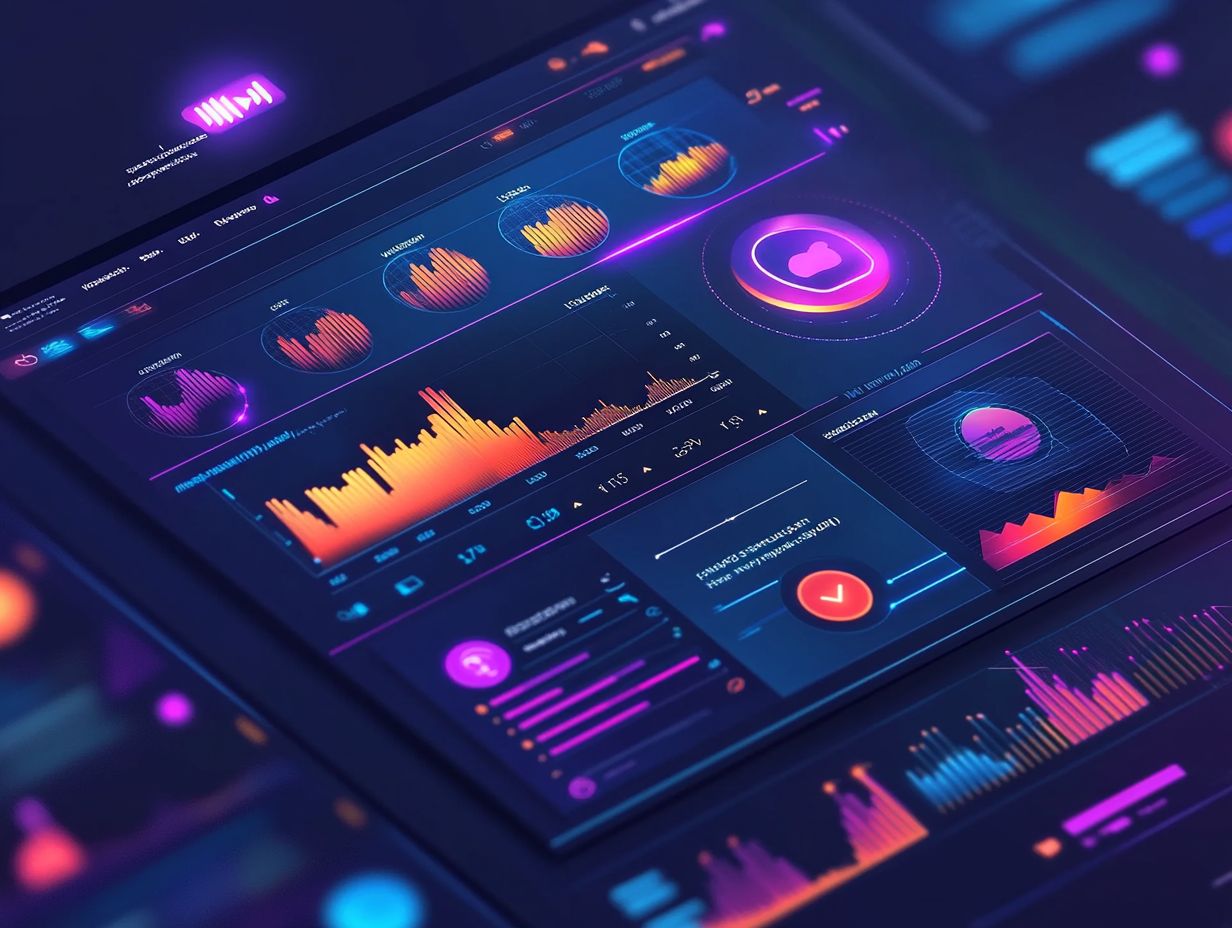How AI Can Assist in Optimizing for Google’s Core Web Vitals
In today’s digital landscape, website performance is paramount to search engine optimization (SEO), with Google’s Core Web Vitals leading the charge in this evolution.
Grasping these essential metrics can profoundly influence your site’s visibility and user experience. By optimizing for these metrics, you can significantly enhance your overall performance.
This article delves into strategies for improving your approach to Core Web Vitals, the benefits that follow, and the challenges you might face along the journey. Uncover the ways to leverage these tools for your SEO success.
Contents
- What are Google’s Core Web Vitals?
- What is AI?
- How Can AI Assist in Optimizing for Core Web Vitals?
- What are the Benefits of Using AI for Core Web Vitals Optimization?
- What are the Potential Challenges of Using AI for Core Web Vitals Optimization?
- Frequently Asked Questions
- What are Google’s Core Web Vitals?
- Why is optimizing for Core Web Vitals important?
- How can AI assist in optimizing for Core Web Vitals?
- What types of AI technologies can be used for optimizing Core Web Vitals?
- Can AI help with real-time monitoring of Core Web Vitals?
- Is it necessary to use AI for optimizing Core Web Vitals?
What are Google’s Core Web Vitals?

Google’s Core Web Vitals represent a collection of essential factors that are crucial for enhancing user experience on your web pages. These focus on key performance metrics like loading performance, interactivity, and visual stability.
You’ll want to pay attention to Largest Contentful Paint (LCP), which measures how quickly your content loads, First Input Delay (FID), which evaluates how interactive your site is, and Cumulative Layout Shift (CLS), which assesses the visual stability of your page.
Understanding and optimizing these Core Web Vitals is vital for your website s success, as they have a direct impact on SEO and search engine rankings, ensuring that users enjoy a seamless experience while navigating your site.
Why are They Important for SEO?
The significance of Google’s Core Web Vitals for your SEO strategy cannot be overstated; these performance metrics are critical for determining your website’s search engine ranking and overall visibility. By honing in on essential factors like user experience, page speed, and interactivity, you can elevate your site’s performance and align with the expectations of Google s algorithm updates.
Prioritizing Core Web Vitals not only enhances your site’s technical SEO but also leads to lower bounce rates and improved user satisfaction, ultimately boosting your engagement metrics and conversion rates.
Consider this: a website that falls short of these vital benchmarks may suffer from sluggish load times, prompting users to abandon their visit while search engines deprioritize it in rankings. For instance, if a page takes longer than three seconds to load, studies indicate that a significant percentage of visitors will leave before it even finishes rendering.
Optimizing these metrics can dramatically reduce clutter and lag during interactions, significantly enhancing the user experience.
This holistic approach to technical audits and ongoing algorithm evaluation underscores the necessity of consistently monitoring performance benchmarks to ensure lasting success in search visibility.
What is AI?
Artificial Intelligence (AI) stands as a transformative technology that simulates human intelligence through the crafting of algorithms and models. This enables machines to perform tasks that usually necessitate human-like capabilities, such as reasoning, learning, and problem-solving.
In the dynamic world of digital marketing and SEO, AI encompasses a range of components, including machine learning and predictive analytics, providing you with powerful tools for making data-driven decisions and optimizing your website.
By harnessing the potential of AI, you can streamline processes like automated testing, content optimization, and user engagement strategies, ultimately enhancing the overall digital experience for your audience.
How is AI Used in SEO?
AI is transforming the landscape of Search Engine Optimization (SEO) by offering cutting-edge solutions for content optimization, keyword analysis, and user engagement strategies that elevate your search visibility. By sifting through vast datasets and recognizing patterns, AI tools can anticipate algorithm updates and adjust your website elements accordingly, improving your ranking signals.
With AI-driven analytics at your disposal, you can monitor user behavior and preferences, enabling you to craft personalized content that truly resonates with your audience and drives higher engagement rates.
Beyond these advantages, AI plays a pivotal role in refining your content strategy by suggesting topics that align with trending searches and user intent. This give the power tos you to generate content that not only attracts clicks but also keeps readers hooked, which is vital for enhancing engagement metrics.
By harnessing advanced AI technologies like natural language processing and machine learning, you can unlock valuable insights through performance metrics and data visualization techniques. These tools not only refine traditional keyword research methods but also provide you with a competitive edge by uncovering opportunities that can lead to significantly improved organic reach.
How Can AI Assist in Optimizing for Core Web Vitals?
AI has the potential to transform how you optimize Core Web Vitals by offering actionable insights and automating processes that enhance page speed, user experience, and overall site performance. With advanced algorithms and machine learning techniques at its disposal, AI tools can meticulously analyze user data to pinpoint areas needing improvement in loading performance, interactivity, and visual stability.
By adopting AI-driven optimization strategies, you not only elevate your Core Web Vitals metrics but also cultivate a more responsive and enjoyable experience for your users crucial elements for retaining traffic and boosting conversion rates.
1. Improving Page Load Time
Improving page load time is essential for optimizing your website, as it directly influences user experience and engagement. With the ever-growing reliance on mobile devices and the demand for swift-loading websites, leveraging AI can revolutionize various optimization techniques. This includes image compression, resource optimization, and utilizing content delivery networks (CDNs) to minimize server response time. By honing in on enhancing your page load time, you can significantly decrease bounce rates, elevate user satisfaction, and ultimately boost your SEO performance.
Several key factors affect load time, such as the size of web assets and the efficiency of your code. You can optimize these elements through practices like asynchronous loading, which allows the browser to load resources in a non-blocking manner, ensuring that critical elements are prioritized.
Moreover, refining your CSS, JavaScript, and HTML files can drastically reduce payload size, leading to improved overall performance. AI tools can analyze your resource loading patterns, providing intelligent recommendations for caching strategies and preloading techniques. This ensures that users enjoy a seamless interaction with your website, fostering loyalty and enhancing conversions.
2. Enhancing User Experience

Enhancing user experience (UX) is crucial for driving user satisfaction and engagement on your website, and AI is your secret weapon in achieving this goal through personalized content and user feedback analysis. By harnessing AI-driven tools, you can delve into user interactions and preferences, crafting tailored experiences that truly resonate with your audience. This approach will lead to increased user retention and a lower bounce rate.
Using AI to monitor performance metrics allows you to make informed, data-driven decisions that continuously elevate the overall UX.
Moreover, AI applications like chatbots offer real-time assistance, ensuring that your users receive immediate responses to their inquiries, which dramatically improves their journey on your site. These intelligent systems can learn from user behavior, enabling them to suggest relevant content and effectively enhance engagement strategies.
By integrating these AI tools, you can gather valuable insights into user preferences, tailor your marketing efforts, and even anticipate user needs, ultimately creating a seamless experience. This strategic approach not only fosters a more engaging environment but also helps you build long-term relationships with users, resulting in loyalty and satisfaction that can drive your success.
3. Identifying and Fixing Technical Issues
Identifying and fixing technical issues is essential for maintaining a healthy website, and leveraging AI can significantly streamline this process with automated site audits and performance analysis. By utilizing AI tools, you can swiftly detect problems like slow server response times, resource optimization needs, and flaws in site architecture that adversely affect your Core Web Vitals metrics. Tackling these technical challenges not only improves your website’s health but also elevates the user experience and enhances your search engine ranking.
Beyond these foundational aspects, AI is instrumental in identifying issues related to URL structure, schema markup, and compliance with web accessibility standards. The systematic analysis offered by AI technology can identify malformed URLs, clarify content relationships through enhanced schema integration, and ensure your site meets accessibility requirements.
Engaging in regular site analysis powered by AI allows you to prioritize these fixes, leading to sustained optimizations and improved search visibility. Embracing AI-driven tools for ongoing monitoring not only conserves time and resources but also fortifies your online presence, ultimately driving greater engagement and conversions.
4. Personalization and User Engagement
Personalization stands out as a powerful strategy for enhancing user engagement, and AI truly excels at delivering experiences tailored to individual preferences and needs. By analyzing user behavior and engagement metrics, AI can help you craft content strategies that resonate with your audience, ultimately leading to higher conversion rates and increased user satisfaction. This targeted approach not only elevates the user experience but also enhances your website’s performance regarding Core Web Vitals metrics.
Consider how dynamic website elements can shift based on real-time data, presenting your visitors with tailored offers or content that aligns perfectly with their previous interactions. Utilizing A/B testing, you can experiment with various personalized strategies, refining your approach through data-driven decisions. By leveraging insights gained from user data, you can effectively optimize your engagement strategies, leading to improved retention and participation rates.
Ultimately, these methods not only foster a deeper connection with your audience but also drive measurable results for your business as you strive to thrive in a competitive digital landscape.
What are the Benefits of Using AI for Core Web Vitals Optimization?
Harnessing AI for Core Web Vitals optimization presents a wealth of advantages that can elevate your website’s performance, enhance user experience, and improve your overall search engine visibility. With AI-driven tools at your disposal, you can streamline processes, automate testing, and gain valuable insights into performance metrics.
This give the power tos you to make informed decisions that can lead to substantial improvements. By leveraging AI, you ll not only save time and resources but also achieve superior optimization results, ultimately enhancing user satisfaction and engagement.
1. Saves Time and Resources
AI-powered optimization tools offer you the remarkable advantage of saving significant time and resources by automating processes that typically demand manual intervention, such as site audits and performance monitoring. This newfound efficiency give the power tos your team to concentrate on higher-level strategies and enhancements, ultimately driving down operational costs while improving your Core Web Vitals metrics.
Consider the implementation of automated reports: they can banish the monotonous task of gathering data from various sources, delivering insights on site speed, web usability, and overall performance in a clear and concise format. With real-time performance tracking, your team can swiftly pinpoint technical issues as they arise, enabling immediate corrective measures. This proactive strategy not only conserves precious resources but also guarantees that your optimization efforts remain in perfect harmony with user expectations and search engine requirements.
2. More Accurate and Efficient
The integration of AI in optimizing Core Web Vitals transforms the way you analyze website performance metrics, providing you with a more accurate and efficient approach to pinpointing issues and identifying areas for improvement. By utilizing the strength of machine learning algorithms, these AI tools can uncover patterns and trends within user data, give the power toing you to make informed decisions that enhance both optimization efforts and the overall user experience.
This shift toward data-driven decision-making highlights the significance of real user metrics. As you leverage AI technologies, you’ll find it easier to assess user feedback, ensuring that the solutions you develop remain contextually relevant and impactful. This seamless integration of AI not only sharpens your optimization strategies but also cultivates an environment where you can proactively adapt to the evolving needs and behaviors of your users.
In the end, the improved accuracy in performance assessments leads to more effective resource allocation, streamlining processes that ultimately result in higher user satisfaction and enhanced website effectiveness.
3. Provides Valuable Insights

AI offers you invaluable insights into user behavior, performance metrics, and site health, give the power toing you to understand your audience more profoundly and make informed, data-driven decisions for optimization. By analyzing extensive datasets, AI tools can uncover trends and provide recommendations that enhance website performance and elevate your Core Web Vitals metrics.
For example, user journey analysis allows you to see how visitors navigate through your site, highlighting any bottlenecks that could be stifling conversions. Armed with such insights, you can adapt your content strategy to better align with user expectations, resulting in engagement strategies that truly resonate with your audience.
By examining traffic patterns, you can anticipate peak usage times and optimize server performance to ensure a seamless experience. Incorporating data visualization techniques can further clarify these findings, making it easier for you to grasp complex information and swiftly implement necessary changes in your technical SEO practices.
Ultimately, this harmonious blend of insights not only drives higher traffic to your site but also fosters a deeper connection with your users.
What are the Potential Challenges of Using AI for Core Web Vitals Optimization?
Leveraging AI for optimizing Core Web Vitals can bring a wealth of benefits, but it’s crucial for you to recognize the potential challenges that may arise during implementation. You might encounter issues such as:
- the absence of a human touch in automated decision-making,
- the financial implications and accessibility hurdles of advanced AI tools, and
- the reliance on data and algorithms that can occasionally result in skewed insights or misinterpretations of user needs.
Being aware of these challenges will help you navigate the landscape more effectively and harness the full potential of AI in your optimization efforts.
1. Lack of Human Touch
One of the significant challenges you may face when relying solely on AI for Core Web Vitals optimization is the potential absence of that essential human touch, which profoundly influences user experience and engagement. While AI shines in data analysis and automation, it often misses the emotional and contextual nuances that only human marketers and web designers can provide, leading to a less personalized experience for your users.
The optimization process requires a delicate balance between technological prowess and human insight. After all, it’s human intuition that interprets the subtle desires and preferences of users in ways that machines simply cannot. This intuition is key to crafting engaging digital experiences that resonate on a personal level, allowing for creative solutions that AI might not spontaneously generate.
By effectively combining AI’s efficiency with your creative instincts, you can significantly enhance the digital user experience. This ensures that every interaction feels authentic and is tailored to meet the unique needs of each visitor. Ultimately, this synergy fosters improved engagement, retention, and overall satisfaction.
2. Cost and Accessibility
The cost of implementing advanced AI tools can present a significant barrier for many businesses, especially small and medium enterprises aiming to optimize their Core Web Vitals. While these tools come with notable advantages, the financial commitment can feel overwhelming, prompting concerns about accessibility and the potential return on investment for those with limited budgets for premium solutions.
It s essential for your organization to assess not just the initial expenses but also the ongoing costs associated with maintenance and updates. In many instances, exploring scalable alternatives can offer a more feasible financial route without sacrificing effectiveness.
By honing in on performance benchmarks and leveraging existing platforms that incorporate AI-driven features, you can enhance your website’s health and user experience while remaining mindful of budget constraints. These solutions typically provide the flexibility to gradually scale your AI usage as you begin to see positive impacts on operational efficiency and customer engagement, ultimately leading to a stronger ROI over time.
3. Dependence on Data and Algorithms
A potential challenge you may encounter when using AI for optimizing Core Web Vitals is the heavy reliance on data and algorithms. This dependence can lead to inaccuracies if the underlying data is flawed or misinterpreted. As AI models analyze user behavior and performance metrics, any discrepancies or biases in the data can skew insights, resulting in suboptimal optimization strategies.
This prompts a critical examination of how such inaccuracies can hinder your data-driven decisions, ultimately impacting your website s performance and user experience. When algorithms rely on biased data inputs, the resulting optimization efforts may highlight certain user behaviors while ignoring others, which could compromise both fairness and effectiveness.
To mitigate these risks, it s essential to continually refine your data inputs and incorporate human analysis, allowing for a more nuanced understanding of performance metrics. Regular technical audits are crucial for validating the quality of the data you use, underscoring the importance of maintaining integrity and accuracy throughout the optimization process.
How AI and Core Web Vitals Work Together for SEO Success
AI and Core Web Vitals come together to form a formidable framework for achieving SEO success. By harnessing AI-driven insights and optimization tools, you can significantly enhance your website’s performance metrics and user engagement.
With AI at your disposal to analyze and improve Core Web Vitals, you give the power to your business to boost user satisfaction, optimize site speed, and align your digital strategies with the ever-evolving SEO standards set by search engines like Google.
This dynamic collaboration enables a more nuanced approach to analyzing the user journey. AI can help you identify bottlenecks and suggest actionable performance improvements tailored to the unique needs of your website.
For example, by integrating advanced AI algorithms into your optimization processes, you gain deeper insights into user behaviors, leading to a seamless experience that keeps visitors coming back.
By monitoring real-time data, you can swiftly adjust your strategies, ensuring that your digital marketing efforts not only meet but exceed the expectations of both users and search engines. This heightened focus on crucial metrics such as loading time and interactivity reflects a commitment to quality, further enhancing your SEO rankings.
Frequently Asked Questions
What are Google’s Core Web Vitals?
Google’s Core Web Vitals are a set of metrics that measure the user experience on a website. There are three core metrics: Largest Contentful Paint, First Input Delay, and Cumulative Layout Shift.
Why is optimizing for Core Web Vitals important?
Optimizing for Core Web Vitals can greatly improve the user experience on your website, leading to increased user engagement, satisfaction, and potentially higher search rankings on Google.
How can AI assist in optimizing for Core Web Vitals?
AI can analyze large amounts of data and make data-driven decisions to improve your website’s performance in the Core Web Vitals metrics. It can also automate the process of making necessary changes to your website.
What types of AI technologies can be used for optimizing Core Web Vitals?
There are various AI technologies that can assist in optimizing Core Web Vitals, such as machine learning algorithms, natural language processing, and computer vision. Each technology can be used for different purposes, depending on your website’s needs.
Can AI help with real-time monitoring of Core Web Vitals?
Yes, AI can continuously monitor your website’s performance in the Core Web Vitals metrics and provide real-time alerts and recommendations for improvement. This allows for quick and efficient adjustments to be made to your website.
Is it necessary to use AI for optimizing Core Web Vitals?
No, it is not necessary to use AI for optimizing Core Web Vitals. However, AI can greatly speed up and improve the process, especially for larger and more complex websites. It can also provide valuable insights and recommendations that may not be easily identified by manual analysis.







